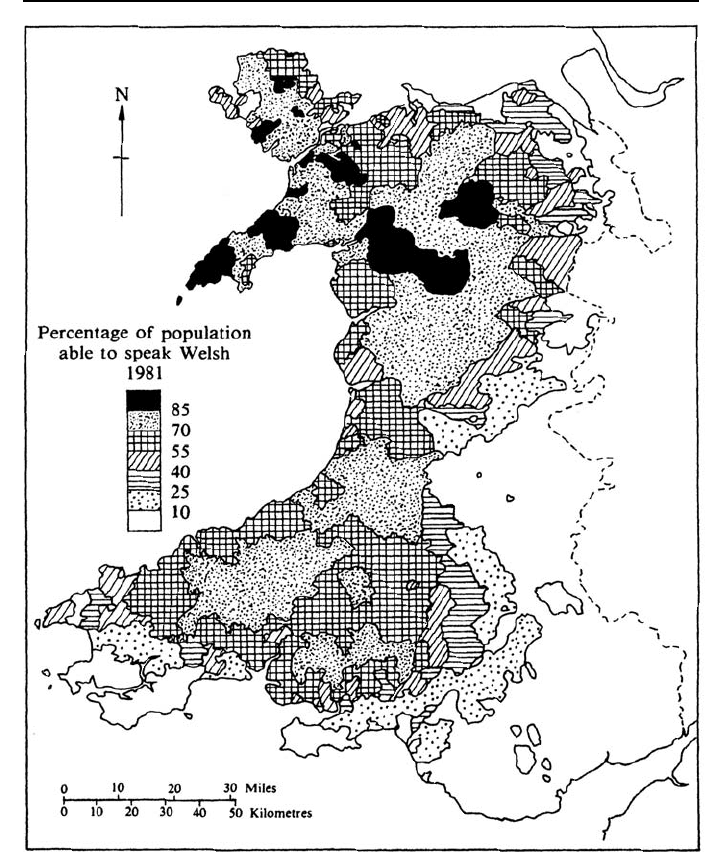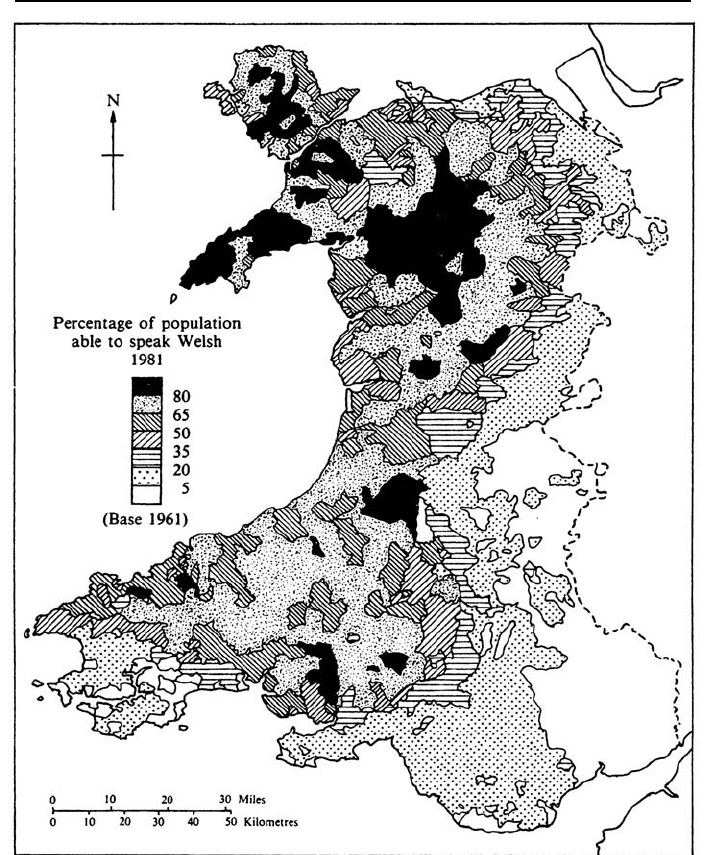Ball Martin, M?ller Nicole. The Celtic Languages
Подождите немного. Документ загружается.


666 THE SOCIOLINGUISTICS OF THE CELTIC LANGUAGES
of the culture, heritage and history of the areas into which they settle and care less about
the adverse impact which they may have on the fragile balance of rural community life.
14
This immigration accelerated during the second half of the 1980s partly because of the
‘post- industrial’ factor and partly because of cheaper housing in comparison with house
prices in England, particularly in the south- east. These population changes, with the in-
migration of English families being greater than the out- migration to urban areas, indicate
Figure 14.5 Distribution of Welsh speakers, 1961. Source: after Aitchison and Carter
1985

THE SOCIOLINGUISTIC CONTEXT OF WELSH 667
a displacement of the Welsh- speaking population which in turn will dilute the intensity of
Welsh speakers in what were predominantly Welsh- speaking areas. Linguistic assimilation
of immigrants, particularly of the young and of young parents, would seem to be the only
hope of retaining the Welsh- language ethos and character of communities in Gwynedd,
and parts of Dyfed. Greater linguistic awareness on the part of Welsh speakers themselves
and a greater institutional use of Welsh has certainly given the language greater prestige,
and this in turn creates a more favourable language- learning environment. The fact that
local authorities (for example, Gwynedd County Council) attempt to provide a bilingual
service has resulted in the introduction of Welsh- language classes during working hours,
and non- Welsh- speaking offi cers are encouraged to participate in such classes. This would
seem to be an important reversal of past attitudes where an English- speaking newcomer
was not expected to learn Welsh; when bilingualism operated for Welsh speakers only.
Another insight into the patterns and causes of erosion arises out of Bowen and Car-
ter’s (1975) comments concerning Welsh oracy and literacy. They noted that there was a
high tendency for a decline of Welsh dominance in the period 1961–71 in Welsh- speaking
areas where low reading and writing proportions were recorded in 1971. Low levels of lit-
eracy in Welsh were, in fact, an indicator of possible further erosion in the future. Their
study also highlighted the total ineffectiveness of Welsh- language teaching within the edu-
cational system in that it could produce communities where oral fl uency in the language
could be undermined by a necessity to switch languages when changing from the oral to
the written medium. Low literacy levels in Welsh inevitably led to a restrictive spectrum
of registers and poor control and competence, which in turn led speakers to regard the
vernacular as being inferior to their competence in English, thus facilitating a language
switch. ‘Welsh oracy without literacy is like a body devoid of limbs. It may have life but
because of limited usefulness, survival may be diffi cult’ according to Baker (1985: 21).
The 1981 census shows that the somewhat diminished 70 per cent Welsh density heart-
lands of 1971 (Figures 14.6, p. 668, and 14.7, p. 669) had been further eroded during
the intercensal period. The spatial continuum, although partially broken in the Severn/
Dyfi mid- Wales area, was by 1981 totally fragmented into six isolated islands. Central
and south- west Anglesey remained, and mainland Gwynedd stayed almost intact. Dyfed,
however, was fragmented into four different areas. Gwynedd has the highest density of
Welsh speakers. The fi ve wards which contain over 90 per cent Welsh speakers are in
Gwynedd, namely Caernarfon, Penygroes, Porthmadog, Llanaelhaearn and Llanuwchl-
lyn. Areas which contain over 80 per cent density of Welsh speakers are again mostly in
Gwynedd (Figure 14.8, p. 670). The areas showing a decline from 80 per cent in the inter-
censal period are predominantly in Dyfed and north- west Powys. This is a cause for great
concern, but it also shows that some of the positive policies adopted in Gwynedd in regard
to the language have borne fruit.
The general picture may appear dismal. There has been a decrease in the spatial dis-
tribution of Welsh speakers and when they are expressed as a proportion of the total
population of Wales, there is further erosion, but it is somewhat encouraging to realize
that the rate of erosion has been considerably diminished. During the 1950s the erosion
rate was 2.9 per cent and it was 5.2 per cent from 1961–71 but down to 1.9 per cent during
the 1971–81 period. Carter (1985: 102) argues that percentage terms do not necessar-
ily give the whole picture. In 1981, in terms of actual numbers, there were 15,081 Welsh
speakers in Cardiff constituting 5.73 per cent of the total population of the capital, and
the 7,840 in Caernarfon constituted 86.45 per cent of the population there. By comparing
changes in the numbers of Welsh speakers during the 1961–71 period with the fi gures for
1971–81, Carter was able to show the increase/decrease trends and reversals over the two

668 THE SOCIOLINGUISTICS OF THE CELTIC LANGUAGES
decades. During the 1961–71 period a total of 680 (73.2 per cent) communities showed
a decrease in numbers and 249 (26.8 per cent) recorded an increase. During the 1971–
81 intercensal period the communities recording a decrease in actual numbers had fallen
to 54.6 per cent, whereas the returns for 45.4 per cent of the communities recorded an
increase! As shown in Table 14.4 (p. 671), the decreases in numbers recorded in 1961–
71 show patterns of acceleration of decrease, deceleration of decrease and a reversal from
decrease to increase in 1971–81.
Carter’s analysis further highlighted the fact that since 1961 there has been a sig-
nifi cant increase in the number of Welsh speakers in areas which were almost totally
anglicized. This is an important trend revealing changing attitudes to the language and
indicating a stubborn determination to preserve and disseminate the language where it
previously had no status whatsoever.
Figure 14.6 Welsh heartlands, 1971. Source: after Baker 1985

THE SOCIOLINGUISTIC CONTEXT OF WELSH 669
This was brought about partly by a migration into anglicized areas of a professional,
educated but highly upwardly mobile Welsh- speaking element. A new commitment to the
language, however, is now spreading, particularly with the provision of Welsh- medium
education.
15
The age profi le of Welsh speakers bears this out. In Gwynedd, the traditional
stronghold of Welsh, one would expect to have more children speaking Welsh than people
in the middle- age group. Gwynedd County Council’s education policy readily explains
this phenomenon, but the same pattern was also recorded in Clwyd, Mid Glamorgan and
Figure 14.7 Distribution of Welsh speakers, 1981. Source: after Carter 1989

670 THE SOCIOLINGUISTICS OF THE CELTIC LANGUAGES
South Glamorgan. This is an encouraging factor which again may be explained by refer-
ence to the success of Welsh- medium education in these areas, and to its high profi le in
attracting a high percentage of pupils from non- Welsh- speaking homes. In Dyfed, West
Glamorgan and Powys there is some cause for concern. The age distribution shows that
the percentage of schoolchildren who speak Welsh is much lower than the percentage
of elderly people doing so. In these areas Welsh speaking is a phenomenon associated
mainly with older people. But one must also bear in mind that during the 1971–81 period,
Figure 14.8 Distribution of areas showing an 80 per cent density of Welsh speakers in
1981. Source: after Aitchison and Carter 1985: 17

THE SOCIOLINGUISTIC CONTEXT OF WELSH 671
the rural areas of Dyfed and Powys had to contend with a new problem – immigration of
younger English- speaking families on a scale which made cultural and linguistic assimi-
lation virtually impossible without additional resources and proper linguistic planning.
The 1981 census revealed that 72.1 per cent of the Welsh- speaking population is liter-
ate in the language. This was only marginally lower than the percentage of 73.2 per cent
for 1971 (Bowen and Carter 1975). As in 1971, low literacy levels tend to coincide with
low density levels which may be interpreted as indicating that the language is in greatest
peril of being eroded and replaced by English in areas with a low literacy level. In effect
it means that in such communities, the full potential of the register range is not realized in
Welsh, and so consequently a change in mode of discourse from the spoken to the writ-
ten necessitates a language shift. Such a phenomenon is quite common in other bilingual
communities where literacy is equated with education, administration and institutional
bodies, and hence with the high prestige variety (Gal 1979; Dorian 1981). For bilingual-
ism to remain stable in a non- diglossic situation there must be an equilibrium between
oracy and literacy. The latter has a stabilizing effect upon a language because it gives its
speakers access to accepted standard and literary forms. When they do not have control
over all the medium possibilities, speakers will invariably give their own non- literary ver-
nacular a low rating, thus facilitating language shift to the high- prestige language, in this
case English.
In 1981 wards containing over 70 per cent of Welsh speakers tended to show the high-
est levels of literacy among their speakers. Areas with lower densities of Welsh speakers
contained the highest levels of illiteracy. ‘Illiteracy in Welsh is mostly to be found amid
Welsh speakers in wards where Welsh is spoken by the few rather than the many. The per-
sonal cost–benefi t balance for Welsh speakers who are in a minority may tilt against being
literate in Welsh. Literacy in such areas may have low currency value’ (Baker 1985: 25).
That may indeed be the overall pattern, but it is always dangerous to generalize. Baker
(1985: 27) makes the point very clearly that not all areas within the 70 per cent isopleth
exhibit high levels of literacy.
16
Similarly, areas with less than 20 per cent Welsh speakers
Table 14.4 Numbers of Welsh speakers: changes 1961–71, 1971–81
1961–71 Changes in the decrease and
increase areas of 1971–81 period
1971–81
Communities
showing a
decrease
73.2% Acceleration of decrease 15.4%
Deceleration of decrease 29.8% 54.6% Decrease
Increase 28.0%
Communities
showing an
increase
26.8% Decrease 9.4%
Deceleration of increase 8.6% 45.4% Increase
Acceleration of increase 8.8%

672 THE SOCIOLINGUISTICS OF THE CELTIC LANGUAGES
are not uniformly low in literacy rates, as Table 14.5 based on Baker (1985: 26) shows.
Literacy remains relatively strong in Gwynedd irrespective of the low density of Welsh
speakers in these fi ve wards. South Glamorgan follows with 71.8 per cent of its wards
scoring an acceptable literacy score in Welsh. Clwyd comes next with 58 per cent. In
all other counties most of the wards with less than 20 per cent Welsh speakers returned
lower literacy rates. As noted above, Gwynedd, Clwyd and South Glamorgan showed a
higher percentage of younger speakers than of middle- aged speakers. In Wales the 1981
census reported that 78.2 per cent of the 15–24 Welsh- speaking age group were literate
in the language, in comparison with a score of 63 per cent for the corresponding 65+ age
group. All this would indicate a necessity to look at survey results continuously and to
bear in mind that language erosion is not the same at different periods, although simi-
lar sociological, economic, political and cultural conditions may prevail. There may be
a low Welsh- speaking density in South Glamorgan and indeed in Mid Glamorgan, but
as pointed out by Ambrose and Williams (1981: 7) high or low percentages alone will
not promote or weaken a language. There are many other factors that combine with den-
sity, such as migration, rural/urban factors, industrialization, and the higher prestige of
the other language (see Denison 1977; Gal 1979; Kahane and Kahane 1979; and Dorian
1981). As pointed out by Fasold, one cannot predict a language shift: ‘Although many of
the often- cited sociological factors are present when a shift does occur it is all too easy to
fi nd cases in which some speech community is exposed to the very same factors, but has
maintained its language’ (Fasold 1984: 217).
The prophets of doom state that all the odds are against the survival of Welsh, but
nevertheless it is still a fact that Welsh today is in a far stronger position in sociolinguistic
terms than it was a century ago. Changing attitudes, greater use and applicability, a higher
socio- economic profi le, and more facilities for learning could all thwart the predictions
of language death. The census fi gures between 1951 and 1981 reveal a certain degree of
inaction and apathy during the preceding decades. In the 1991 fi gures rays of hope were
identifi able which were confi rmed by the results of the 2001 census discussed below.
Table 14.5 Distribution of literacy in wards with less than 20 per cent Welsh speakers
using a Welsh- speaking base. Source: based on Baker (1985: 26)
Clwyd
Dyfed
Gwent
Mid-
Glamorgan
South
Glamorgan
West
Glamorgan
Powys
Gwyn edd
20–39%
literacy
2 (2.5%) 3 (8.6%) 36 (40.4%) 10 (10.4%) 2 (5.1%) 4 (10%) 7 (10.8%) 0
40–59%
literacy
32 (39.5%) 21 (60%) 46 (51.7%) 56 (58.3%) 9 (23.1%) 30 (75%) 28 (43.1%) 0
69–79%
literacy
47 (58%) 11 (31.4%) 7 (7.9%) 30 (31.3%) 28 (71.8%) 6 (15%) 30 (46.1%) 5 (100%)

THE SOCIOLINGUISTIC CONTEXT OF WELSH 673
WELSH- MEDIUM EDUCATION
In the fi eld of education the twentieth century has seen a gradual expansion in the use of
Welsh as a teaching medium, starting with the infants’ schools during the fi rst decade, the
primary schools during the 1930s (in those areas which were predominantly Welsh speak-
ing) and reaching university degree level by the 1960s. The most rapid expansion and radical
developments, however, have been accomplished during the last three decades 1960–90.
During the fi rst six decades, advancement in the use of Welsh for teaching subjects
other than the language itself was rather slow. As early as 1907 the Code of Regulations
for Public Elementary Schools in Wales stated that
Any of the subjects of the curriculum may (where the local circumstances make
it
desirable) be taught in Welsh. Where Welsh is the mother- tongue of the infants that lan-
guage shall be the medium of instruction in the classes. Provision should be made for
the teaching in every school, of Welsh history, and the geography of Wales and Welsh
literature should also be included in the curriculum of higher elementary schools.
This clearly stipulated that subjects other than Welsh itself could be taught partly or
wholly in Welsh. But as Professor Jac L. Williams (1963: 58) stated, ‘Wales continued to
be reluctant to give her national language an important position in the curriculum of her
schools. Welsh was rarely used at all as a medium of instruction beyond the settling in
period in the infants’ school.’
For the previous half century Welsh had been outlawed from the world of education
and a very dangerous diglossic situation came into being. Education, progress and com-
merce were equated with the English language. The only two high- status situations in
which Welsh could be used were religion and culture/entertainment (eisteddfodau,
cyrddau llenyddol, cyrddau cystadleuol, cymanfaoedd canu). As long as Welsh Noncon-
formity stood fi rm, the language held its ground.
17
That did not remain so and for many
speakers, Welsh ceased to be a medium for public interaction. Diglossia- linked bilingual-
ism inevitably led to a language shift in many areas. It is mainly through efforts to secure
a place for it in the educational realm that the language has reasserted its status as a lin-
guistic medium in the public sector. Attitudes have changed considerably from those of
the fi rst decade of the twentieth century, when typical opinions about the usefulness of
Welsh were totally negative. Even Sir John Morris- Jones in his ‘Syllabus of Instruction in
Welsh’, Cymmrodorion y Barri (1912) gave greater importance to the teaching of English:
‘I have no quarrel with those who consider that the fi rst object of the elementary schools
in Wales should be to teach the children English, but I do hold that its second object is to
teach them Welsh.’
Today Welsh is well established as a medium of instruction in education. Indeed it is
now possible for parents to opt for Welsh- medium education for their children from the
nursery age up to university level. At some of the universities in Wales, degree courses in
subjects other than Welsh are available through the medium of Welsh. Teacher training col-
leges also provide instruction, and academic and vocational courses entirely through the
medium of Welsh are available. Business and secretarial courses are also available taking
Welsh as one of the working languages. All further- education colleges in Gwynedd offer
Welsh- medium courses and in order to ensure effective bilingual education it is essential
that equal status be given to both Welsh and English in every aspect of the college’s work
(Gwynedd County Council Language Policy (1975): ix). All this is fairly recent and is the
result of the changing attitudes and language awareness of the past thirty years or so.

674 THE SOCIOLINGUISTICS OF THE CELTIC LANGUAGES
The fi rst Welsh- medium school opened in Aberystwyth in 1939 and it was an inde-
pendent school. Welsh- medium education was a concept which appealed mostly to
academics and a few professional people. By 1950 a total of seven designated bilingual
primary schools operated. By 1960 the number had increased fourfold to twenty- eight
and one secondary school was opened in the north- east – Ysgol Glan Clwyd. During the
1970s and 1980s expansion in the bilingual school category (Ysgolion Cymraeg) was
probably one of the most important language- maintenance factors of the century. These
schools helped to stem a language- shift process that had been going on in the anglicized
areas since before the turn of the twentieth century. During the 1988–9 school year a total
of 22,638 pupils attended the schools whereas twenty years earlier all children in those
same catchment areas would have received monolingual English education. During the
1950s and 1960s in these areas it was a struggle for Welsh- speaking parents to bring up
their children to speak Welsh because the home was the only domain where they would
hear the language being used. Mixed- language families found it virtually impossible
to ensure that their offspring would be bilingual. Certain degrees of success could be
achieved when such children attended Welsh- medium Sunday schools. This was the only
environment with which they could associate Welsh – in addition, of course, to the infor-
mal but socially restricted home environment. The result was that parents took the easy
option and spoke English with their children. In a Ministry of Education Survey (1950)
(cited by Betts 1976: 6), it was noted that in the old county of Glamorgan only 42 per cent
of Welsh- speaking parents opted to speak the language with their children. In the pre-
dominantly Welsh- speaking heartland of Meirionethshire, 96 per cent spoke Welsh with
their children. If only the father spoke Welsh, in Glamorgan a mere 4 per cent opted to
speak the language with their siblings. In homes where only the mother spoke Welsh the
retention rates for the Welsh language were 7 per cent in Glamorgan and 39 per cent in
Meirion. The availability of Welsh- medium schools in anglicized areas has transformed
the situation from a negative to a positive standpoint vis- à- vis the language. At fi rst the
Welsh- medium schools had to prove themselves to be capable of giving a balanced and
effective education. The old myth that pupils’ English would suffer had to be dispelled
and the advantages for the pupils of bilingual education had to be expounded. In terms of
educational and cultural achievements these bilingual schools were and are a great suc-
cess. They do not teach language in a vacuum. It is the main medium of instruction right
across the curriculum, not just for Welsh literature, religious education or history, but also
for mathematics, computer studies, geography, environmental studies and, at secondary-
school level, economics, home economics, physics, biology and chemistry. These schools
intentionally establish a Welsh ethos within an anglicized setting and deliberately pro-
mote the Welsh dimension through the curriculum. Extra- curricular activities play a very
important role in these schools and are extremely important factors for imparting Welsh
culture and values to the pupils. It can, of course, be argued that this social setting for such
activities as choir practice, folk dancing or penillion singing is rather artifi cial in that it is
school linked and teacher controlled. There is an ever increasing danger of the Welsh lan-
guage being associated in the minds of the children with education and school activities
and consequently being restricted to these domains only. In these areas, since local com-
munity life is dominated by English, Welsh- language social activities are evolving along
a social- network basis and the school is pivotal within such a structure. These bilingual
schools have helped to make it possible for individuals and groups to live a full and varied
social life in Welsh even in anglicized and urbanized areas.
As Table 14.6 shows, the growth rate of the bilingual schools between 1950 and 1988
was phenomenal. During the 1970s the number of pupils in bilingual primary schools

THE SOCIOLINGUISTIC CONTEXT OF WELSH 675
increased by 50 per cent and in the secondary sector a 289 per cent growth was recorded.
This occurred at a time when school rolls were generally falling. Between 1980 and 1988 a
24 per cent increase was seen in the primary sector and a 33 per cent increase in the second-
ary sector. It is quite obvious that such an increase in numbers is not from Welsh- speaking
homes alone. A high proportion comes from mixed- language homes where one of the par-
ents may be Welsh speaking, and also from non- Welsh- speaking homes, simply because
parents want their children to grow up bilingually. In many cases it is a matter of bridging
the linguistic gap left by previous generation- linked language shift. The numbers of young
Welsh speakers in the anglicized and industrial areas are increasing annually. Therefore the
designated bilingual schools serve two purposes in that they strengthen and extend the lin-
guistic development of children for whom Welsh is the fi rst language by expanding their
range of registers in Welsh, and they introduce Welsh through play and instruction to non-
Welsh- speaking infants who can then benefi t from Welsh- medium instruction as if they
were native speakers of Welsh. The standardizing infl uence of the schools not only expands
the children’s lexical control and grammatical structures but as dialect surveys have shown,
parents’ lexical ranges can also be considerably extended when they adopt words and struc-
tures to conform with the patterns of their children.
18
Non- Welsh- speaking parents, by
seeing how easily their children’s education has operated, have been prompted to attempt
to learn Welsh themselves. The right motivation is then present: there is a utilitarian reason
for learning Welsh in spite of the fact that it is not generally required within the commu-
nity at large. Such motivation is often fi red by intense enthusiasm and this in turn creates
more supporters for Yr Urdd (‘Welsh League of Youth’), Cymdeithas yr Iaith (‘Welsh Lan-
guage Society’), Mudiad Ysgolion Meithrin (‘Welsh Pre- school Playgroup Association’),
local Welsh societies and clubs. In short the Ysgolion Cymraeg (bilingual schools) have
given the language educational and social prestige at a time when language- maintenance
action was long overdue. These schools have certainly produced a legion of fl uent learners,
but real success can only be measured in terms of the numbers who will keep on using the
language after they leave school and who will participate in Welsh- medium social activi-
ties. There is the ever increasing danger of Welsh becoming a classroom language alone,
unless children can socialize in Welsh in a fairly wide and representative spectrum of situa-
tions. This obviously calls for a multiplex system of social networks which can give Welsh
a valid role in a realistic cross- section of social situations.
Over the years there has been an expansion in the use of Welsh as a teaching medium
in schools other than the sixty- seven designated bilingual primary schools. This is partic-
ularly true of schools in the traditional Welsh heartlands of Dyfed, Powys, Gwynedd and
Clwyd as illustrated in Table 14.7 (overleaf).
During 1987–8 a total of 363 primary schools in Wales taught solely through the
medium of Welsh, catering for 12.2 per cent of the primary school population, and a
Table 14.6 Designated bilingual schools (Ysgolion Cymraeg). Source: Welsh Offi ce
(1988: 4)
1950 1960 1970 1980 1983 1984 1985 1986 1987 1988
Primary schools 7 28 46 54 64 64 64 67 67 67
No. of pupils — — 6,253 9,769 10,447 10,788 10,978 11,472 11, 539 12,112
Secondary
schools
01411131416 16 1616
No. of pupils — — 2,017 7,860 8,933 9,576 10,065 10,279 10,620 10,526
